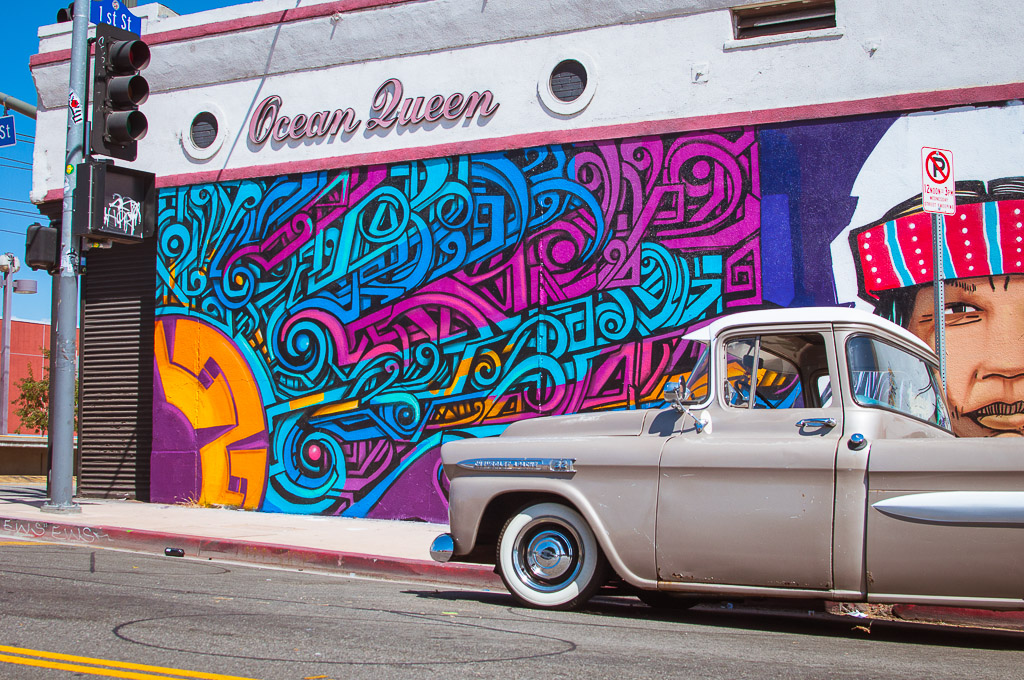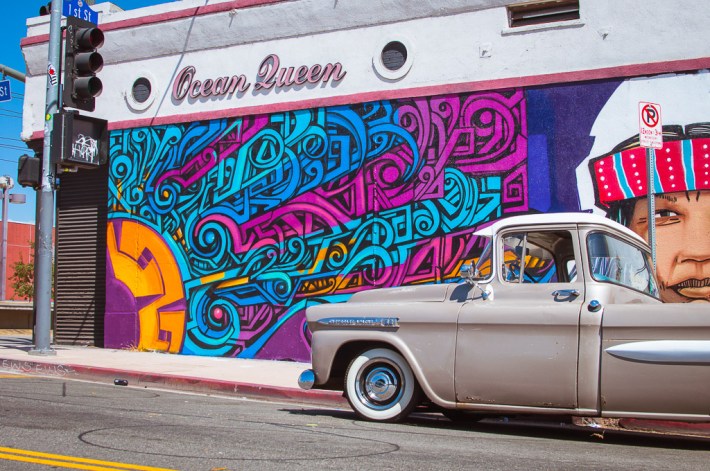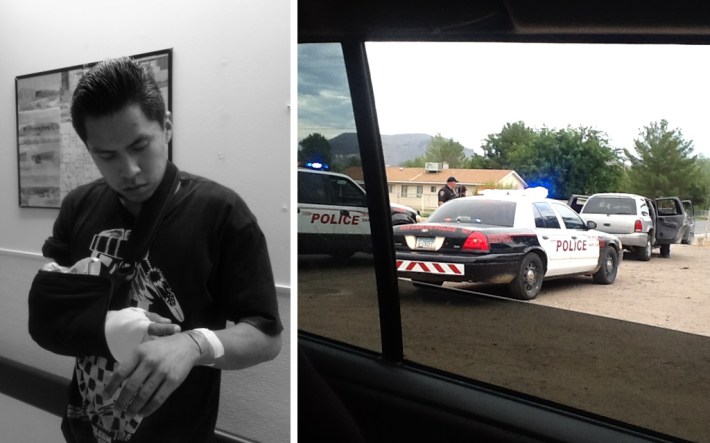What Tribe Project (LA TACO recap) is exhibiting at Self Help Graphics til October 5th, a definite must-see if you're in town right now. LA TACO's Erwin Recinos was able to speak with Douglas Miles, artist/curator of What Tribe about the opening reception, the latest SHG mural and what life is like on the Apache Reservation in San Carlos, Arizona.
How was the reception of the What Tribe Project you curated at Self Help Graphics?
The reception at Self Help Graphics was an amazing mix of artists from all genres. I saw photographers, painters, graf heads, writers, museum staff, the Boyle Heights community, L.A. Native American community, community activists, and established artists: Estevan Oriol, DEFER, Gaijin Fujita (just to name a few) rolled through in support. I was humbled and honored at the show of support. Thank you Los Angeles.
Was it difficult to assemble a group of artists like this? Where their any challenges?
It's not as difficult as you might think to assemble the artists. What is challenging is mobilizing and moving the varied artists work from places all over the country to East Los Angeles. We had a small budget but Self Help Graphics was instrumental in assisting with many of the logistics of holding the show there. Everyone from Eriberto Oriol (photographer / documentarian /artist) to Dewey Tafoya (screen printer/ graphic design artist) pulled together to drive nails, hang art, and donate time and effort to help execute the show.
Why is Los Angeles an important city for What Tribe Project?
The theme of WHAT TRIBE was "stereotype" of varied "tribal" people of color in media. Los Angeles being a media Capitol is the perfect venue to have this conversation about the negative effects of stereotypical imagery in popular culture regarding people of color.
During your time in LA you were able to work on a mural at Self Help Graphics. What was the theme and who was involved in it.
The mural in Boyle Heights at Self Help Graphics is a proactive positive way to bring a visual indigenous aesthetic point of view to a city known for its cultural diversity. Mural art is about becoming part of the community. Murals allow an artist to have a larger conversation within a community. Mural art isn't necessarily about "being seen" as much its really about "seeing" the world around you and speaking on it. Like a skater having fun turning the streets into a moving playground, we wanted to become "one with the environment". As a Native American myself (San Carlos Apache /O'Odham) it was an honor to be invited by friends in Los Angeles, Self Help Graphics (and curate What Tribe) to work in a respected Chicano East Side community with a great tradition of art for the people and "tribes".
The show is inherently about tribal self-definition. There's a long history of institutions attempting to tell or define our "native" story. All artists must endeavor to define their own work. Artists often think someone will do it for them. We voice our unique story through art as we speak for ourselves as Native people, artists, designers, film makers, survivors and creators gifted by the creator, not as victims or tragic icons. We welcome making friends that respect our creative processes. The mural artists were: Thomas "Breeze" Marcus, Vyal Ryes, Renelle White Buffalo and myself, Douglas Miles.
In our conversations, here in LA and via email, you mention the Rez Life. Please explain what life is like in San Carlos AZ on the Apache Reservation.
I say Rez Life is usually quiet. It consists of solitude, solace, quiet isolation. On the downside there are numerous social logistical challenges (unemployment, poverty, drug & alcohol abuse, violence, etc.). However by maintaining family ties, adhering to tribally structured social mores, we remain strong and support one another here, in spite of the challenges.
Are their other influences on the reservation that are breathing life into your community?
I think a lot of the larger influences actually come from the artists like those from What Tribe, skaters or (future) musicians that come from out of our community , work in larger communities, then return to tell the story and inspire local youth. It's hard to create change if you haven't experienced a certain type of success or understand how creativity works and why creativity is important.
What personal influences did you have growing up on the Rez that shaped your life as it is today?
All my personal influences come from my older brothers and sisters who were really into music, art, film and literature. All those things hold a special place for me. Any artist wanting to become good must really practice. I think to become great you have to study and pay attention to the greats. Often it was just spending time with an older brother, sister, aunt or uncle that shaped me. There's a good way to teach, inspire and lead. Without this tribal process, we're all lost.
With you starting Apache Skateboards and Apache Skate Team, how has that injection of skate culture evolved in your community?
It gave adventurous kids on the Rez something new to do and something to look forward to, look up to besides the typical football or basketball routes. It's evolved to the point where we (Apache Skateboards) have worked with Ipath Footwear and Volcom designing product. This inspired Indian (Native) kids here but nationwide too. Kids pay attention to this and it makes them skate harder and with hope of a greater tomorrow.
What is next for What Tribe project that our LA TACO readers should be looking out for?
Right now I'm looking for other venues, locales, galleries etc. to partner with and would like to see the show travel.
The WhatTribe Project Art Show wasn't about big names, fame or political correctness. It’s about addressing the issue of stereotype via constructive positive dialogue with artists in community. It was also (I hoped) an opportunity for emerging artists to work with more established ones in a new school fashion.
In the process of creating, curating and executing the show, I’ve made new friendships and strengthened old ones. I can’t speak for all artists or tribes, no matter where we’re from we have roots and specific social mores unique to our own families/tribes/cultures. Whether Native Californian or Native American, or both, I wanted to show and share similarities we all have. All of us are “tribal” people in some manner.
We all have a lot of work to do in bringing communities, artists, leaders and tribes together around important issues we all face. I figured WHAT TRIBE was a good place to start. Hope you all get to see the show and of course there will be others. Right now I’m busy writing down thoughts on this show and it’s importance to the communities involved. Thank you all artists and friends that helped along the way. It’s only a beginning.










